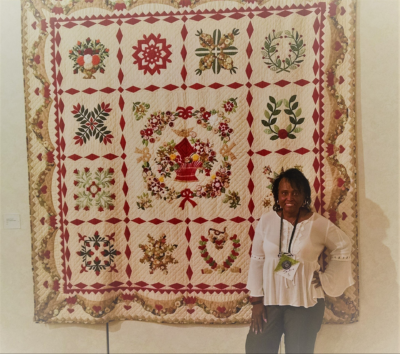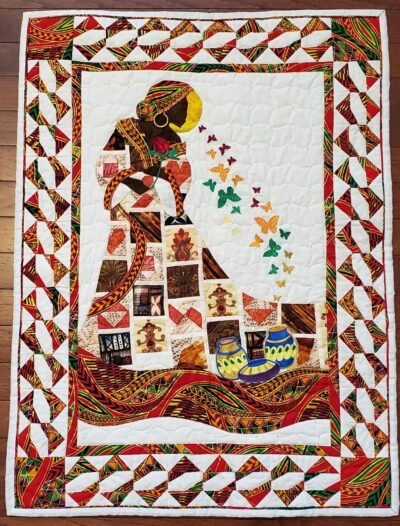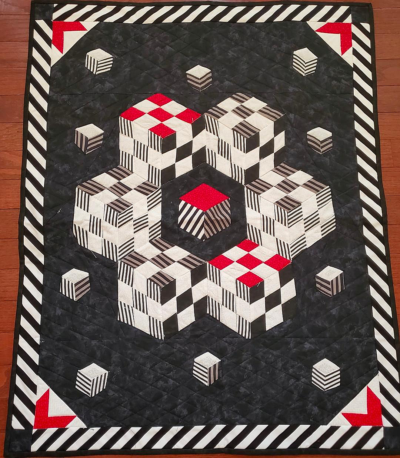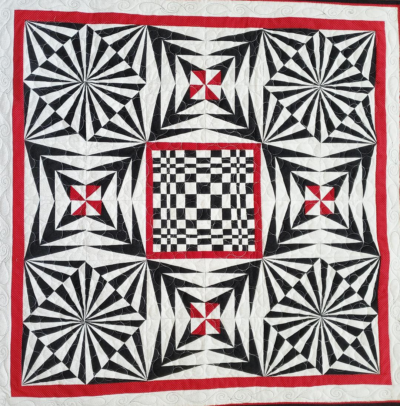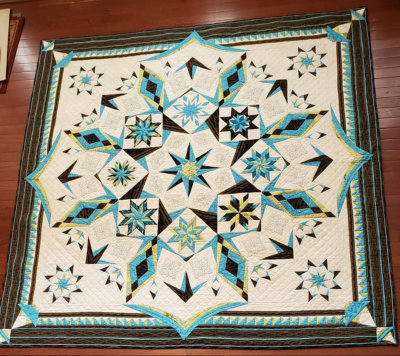Quilting is a timeless art form that weaves together fabric, color, and creativity. Meet advanced quilter Jackie Simpson, whose passion for quilting knows no limits. For nearly 25 years, she has immersed herself in the world of quilting. Much more than a hobby; quilting is a lifeblood for Jackie. She affirms, “Quilting has taken over my life. I eat, sleep, and dream quilts.” And indeed, she stitches every day pouring her heart and soul into each piece.
Jackie’s quilting journey is far from complete. She thrives on challenges. Only the most intricate patterns and difficult techniques make it to her quilting table. For her, the art lies in pushing boundaries and learning something new with every stitch.
The earliest known indication of quilting was an ivory carving found in the Temple of Osiris at Abydos in 1903. Dated approximately 5,500 years ago, or around 35th century BC, it depicts the king or Pharaoh of the Egyptian First Dynasty clad in a quilted mantle or cloak.
Jackie, who calls Delaware home, is an esteemed member of three distinct quilting groups: 1) Ladybug Quilt Guild: The group is a vibrant community of 200 women who share techniques, inspiration and camaraderie. Over the years, the Ladybugs have helped to hone Jackie’s skills. 2) The African American Quilters of Baltimore: Here, Jackie finds sisterhood. These sister-quilters celebrate their heritage through fabric, needle, and thread. 3) The Appliqué Society: They rekindled her quilting fire after the loss of her mother in March 2023. It was their encouragement that helped her revive the art.
In their 47-year marriage, Jackie and her husband Artie have two adult daughters, Angela and Andrea, who have seen their mother transform simple fabrics into stunning works of art. The quilts Jackie creates transcend the limits of her studio – they enter the digital realm as well with her every stitch, carrying the love and promise of more quilts to come.
We sat down with Jackie as she shared her love and passion for quilting.
50BOLD: Jackie, how did you get into quilting?
Jackie: I was a housewife, taking care of my two children. And I was babysitting another child to make money. I wanted to get out of the house. I took an adult education class in 1983/84 and did crafts and other stuff. Quilting didn’t take over until about 2005 and then it just took me over! I got rid of all my other crafts, and got directly into quilting.
50BOLD: What is the average time it takes you to make a quilt?
Jackie: I can make a quilt in two days. But it is going to be something really simple, something that I donate. The average time that it takes me to make a quilt that is more intricate is about two weeks. Then I also have Baltimore Album Quilts, conceived in the 1800s and they take a year and a half to create.
50BOLD: Over a year to make a quilt?
Jackie: Yes, they take a long time because the quilts are done by hand.
I belong to a group called Appliqué Society. There are about 20 women in the group. Every time I attend their gatherings every month, I learn something, and this is why I go. They are amazing quilters.
50BOLD: Now, there are different styles of quilting right?
Jackie; There are a lot of quilting styles. There is appliqué and Baltimore Album quilting which are done by hand. Then there’s patchwork quilting that is created from a piece, to a piece, to a piece.
Paper piecing quilting is my favorite which is when you sew on top of paper, then tear it off to get precise blocks. You can make a beautiful block using the piece quilting technique that is a half-inch or three feet. I also make a lot of memory quilts.
50BOLD: What are memory quilts?
Jackie: Memory quilts celebrate important milestones and are created from things like photos or pieces of clothing. I make a lot of quilts for families to give as gifts. I’ve made pillows for families. I do very few commissions. But I did do a commission with a lady whose mother died. The woman provided me the same photos to use for three pillows she wanted me to make for herself and her two siblings. I made each pillow differently. I just don’t add the photo; I also create a design to go around it.
50BOLD: How do you charge for your quilts, is it by the hour?
Jackie: Someone once wanted me to make a Black Santa Claus for them that took 30 hours. I told the client, ‘For thirty hours of work, I’m going to give you a deal and charge you $110 for the quilt.’ Unheard of! A quilter does not sell quilts for such a low price. The woman actually responded with, ‘That’s too much money!’ Well, I thanked the woman and now, I have a Black Santa in my closet!
50BOLD: Oh, my God!
Jackie: The Black Santa situations happens all the time! A quilt can run about $300-$400. In the past, I was selling quilts for $150, $200. I was basically working for a dollar an hour! I began giving quilts away about a year ago. It got to a point where the quilts were too intricate for me to give away. If I labored on a quilt for too long, I don’t want to give them away for free. Some of them took 70, 80, 90 hours. So, they just sit in my closet.
I told my daughters that when I die, they should take the quilts to the funeral home to pass them all out. Everyone will go home with a quilt and just like Oprah…’You get a quilt, you get a quilt, you get a quilt!’
50BOLD: (laughs) I’m visualizing your quilted works in an art gallery where people can purchase them. Do you see your quilts in an art gallery?
Jackie: I would love to sell my Baltimore Album quilts because they are intricate. My girls don’t want them; they are too ornate for them. When I pass, my girls joke that the quilts will either go to Goodwill, or become comfy cushions for dog beds. People don’t realize the work that goes into making a quilt. Oftentimes, quilts are just ignored, thrown out, or given away.
50BOLD: What about the members of the quilt organizations you belong to, do they have showings of their work?
Jackie: Most of the time members give their quilts away too! I belong to the African American Quilters of Baltimore. They have a couple of members there who sell their quilts for a small fortune. There’s a senator from Hawaii, I forget her name. I was observing a quilt that was hanging on the senator’s wall that looked familiar. It looked like it was made by one of my quilt sisters, Sandra. I quickly got on the phone to call Sandra. The quilt had indeed been created by Sandra, who didn’t know the senator had bought it. Sandra had sold the quilt to an art gallery that probably purchased it for thousands.
50BOLD: During Black History Month, Target sold quilts in collaboration with the Quilters of Gee’s Bend in Boykin, Alabama. What is Gee’s Bend all about?
Jackie: Gee’s Bend is a little Black town in Alabama. Dr. Martin Luther, Jr. went to Gee’s Bend and he upset the white people in the area. What the town did was take their ferry away. They had no contact with the mainland. They were a very poor, Black town. Later, this white man visited the town, and saw all these people with Utilitarian quilts (quilts made primarily for practical purposes, rather than just for decoration.) The man purchased a bunch of quilts, some said he paid around $3000 which isn’t a lot of money. For the people in the town it was a lot of money. They were so happy they got paid. The man also took videos. He took those quilts and videos to museums like The Smithsonian. The man created marketing merchandise from the sale of the quilts–t-shirts, books; he made millions!
50BOLD: Oh My God!
Jackie: The ladies found out about the marketing and in 2007, they took the man to court. The women sued the man, and won. How much did they win? The amount was not disclosed. Yet, the man is still touring with his books and stuff. The women took back their name. Quilters go to visit them. They also offer retreats where visitors can learn their techniques. The Gee’s Bend Quilters make money.
50BOLD: Can you see the finished product in your head before you physically create a quilt?
Jackie: I actually see a pattern in my head and the colors. If I can’t see it; I can’t do it.
50BOLD: You mentioned the quilts talk to you while you are making them, can you elaborate?
Jackie: As I’m sewing a quilt, it will say ‘You need to put this here. Change that.’ They do talk to me.
50BOLD: You mentioned that there is subtle racism in quilting, can you explain?
Jackie: There is, I tend not to get involved with that. I had two situations. The Baltimore Album quilts which are very intricate and got started in the early 1830s, disappeared in 1865. I went to a meeting, where there was a discussion about Baltimore Album quilting. I wanted to see what the white presenter had to say. I went with Kim Hall, an English professor at Barnard College and historian.
The presenter began discussing how the slaves did not make Baltimore Album quilting. Kim raised her hand and said, ‘But Abraham Lincoln’s seamstress made Baltimore Album quilts and she was a Black quilter.’ The presenter responded with, ‘No she didn’t, she just made dresses.’ Kim stated how the quilt made by the seamstress was in a museum. The white women who allegedly made quilts in the 1800s did not sew. So, when Kim asked the presenter who sewed the quilts for them? The presenter did not know how to respond.
The whole Baltimore Album technique died in 1865. What happened in 1865?
50BOLD: The slaves were emancipated.
Jackie: Yes, if it went away in 1865, what happened at that time. They want to think that all we can do is tribal quilts, ones that don’t require any technique, just simple ones.
The other racist experience I had was in a store that was owned by one of my Ladybugs who knew my work very well. I was there with my mother. I’m standing by a quilt, and I said to my mom, ‘I have to make this quilt. This is amazing!’ A white female stranger overheard my comment and walked up to me to say, ‘You may not know how to do this. You need to know how to quilt first.’
Now, I stared at her and thought to myself, should I do the ugly Black woman thing? This all took place in a matter of seconds, my brain is trying to figure out how to react.
50BOLD: Right.
Jackie: The owner knew me and said, ‘Oh, Jackie can quilt, her quilts are beautiful!’ I exhaled a sigh of relief. That’s what they think of us. They think we can’t do it!
But we quilters are here and there are a lot of us now. There are a lot of Black quilting groups. There is a Black quilter on YouTube called The Quilting Marine. I recently discovered him and I’m now a follower. He quilts blocks and is very traditional.
Another Black quilter was the late Faith Ringgold, whose quilts are beautiful. She created a little bit of abstract artwork and some traditional styles with her quilting.
An up-and-coming quilter is Bisa Butler. She is amazing. I can’t quilt like Bisa. She’s a portrait quilter. She incorporates people and has made a name for herself. Bisa’s quilts probably run from $15,000 to $100,000. The quilts are truly amazing.
50BOLD: You say quilts are your babies, how so?
Jackie: I don’t have any grandchildren. Anyone who is a friend of mine, knows that I will talk about my quilts. My whole world is about quilting. My quilts are my children. Some of them I can’t give away because they are my children.
50BOLD: Really!
Jackie: I’ve formed an attachment to my quilts. There are a couple of them I don’t like, maybe two, but I don’t know if I could give them away. I’ve made probably 300 items, probably more. I only have 70. It tells you how many I’ve given away.
50BOLD: Oh, really. Do you quilt every day?
Jackie: I quilt every day. I’m going to bed now and will be appliquéing in the bed. I’m getting ready to work on another project which is extremely hard. I am only making things now that are difficult and that I have never done before. I am no longer making quilts just to make quilts because I don’t need more in my closet. If I’m not going to learn something, I’m not going to do it.
50BOLD: When your mother became ill, you were her caregiver. Did you completely stop quilting?
Jackie: Yes, I couldn’t sew. I lost all my imagination. I stopped sewing for about a year and it broke my heart because I am a quilter; it is my existence. And when my mother passed, I still could not sew.
50BOLD: No?
Jackie: It took months to get back into quilting. I went to an Appliqué Society meeting. The white ladies got me back into quilting again. I was inspired and haven’t looked back since.
It was all that emotion, my mother’s passing took everything from me. But I am a quilter. Artie would say, ‘Just go in the room and sew Jackie, go sew!’ But quilting for me is not just about sitting at a sewing machine. It’s more than that. I felt like a painter who couldn’t paint.
50BOLD: How did your quilting sisters give you back your inspiration?
Jackie: I saw and appreciated what they were doing for me. They would ask if I needed a pattern or wanted to work on one. You get your blessings where you get it.
I call myself a quilter. I never thought of myself as an artist, but I probably am. I’ve always been taught to be humble. When it comes to quilting, I can do anything except two things: portrait and abstract.
And when it comes to sewing, I can sew anything. I can make coats, I made my own wedding dress.
50BOLD: You made your own wedding dress, impressive! Jackie, do you have any final tips for someone who might want to get into quilting?
Jackie: There are a lot of quilters now; it’s becoming an art.
50BOLD: Oh, really! It’s growing?
Jackie: It’s definitely growing. First, I would find a mentor. Find someone who knows how to quilt and can show you how. You can also look for a fabric, crafts, or quilt store that might offer beginners’ quilting classes.
Buy patterns, work on them. YouTube is an amazing resource; anything you want to learn about quilting can be found there. But finding a mentor is the best way to get started.
50BOLD: I must say, quilting is definitely in your DNA.
Jackie: I do quilting for the challenge of it. Quilting is my heart; it is my love!
Follow Jackie on Instagram: @theres_love_in_every_stitch



